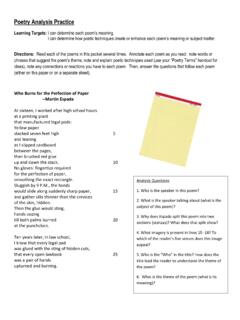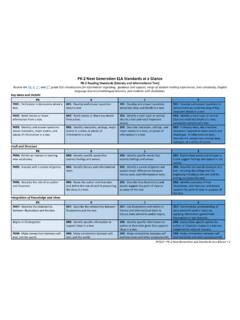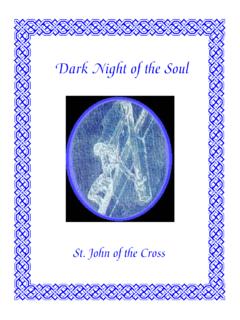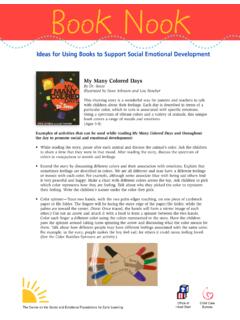Transcription of Year 8 Poetry Unit - Weebly
1 year 8 Poetry Unit 1 year 8 Poetry Land of the Rainbow Gold: Australia year 8 Poetry Unit 2 Poetry The key features of Poetry can be split into five areas: themes, structure, language, tone and purpose. What do these elements mean? Use the mind map to explain each feature. LANGUAGE TONE Poetry THEME PURPOSE STRUCTURE year 8 Poetry Unit 3 Poetic Devices Alliteration: The repetition of a consonant sound in consecutive words. The repetition is usually located at the beginning of the word. Example: The slippery slithering slimy snake. Connotation: When a word suggests something in addition to its ordinary meaning that is its connotation.
2 Example: Father, dad and daddy all mean your male parent, but they have different connotations in terms of your relationship with him. Enjambment: This means run on lines , when the sense of one line runs on into the next line. Example: No more sharing What the hunter brings. Hyperbole: The deliberate use of exaggeration to have an effect on the reader. Example: He knew he was the unluckiest person in the world. Irony: This is when what is said isn t quite what is meant. It can also be implied when the opposite of what we expect occurs. Example: Rain on your wedding day. Juxtaposition: When two things are placed side by side in order to emphasise their differences.
3 The reader notices the differences more strongly because the two things are placed side by side. Example: The sky a romantic red, blazed with burning bones, arms and legs. Metaphor: Something is described in terms of something else. Example: Her eyes are stars in the sky. Onomatopoeia: This is when the word itself mimics the sound it is describing. Example: bang , hiss whip Paradox: This is an apparent contradiction that makes sense after you think about it. Example: Lonely in teeming city crowds Personification: Human or animal emotions and qualities are given to non-human things. Example: The wind howled in agony all day.
4 year 8 Poetry Unit 4 Repetition: When something occurs more than once in the poem. It may be a word that is a repeated or an idea. Example: Alone, alone all all alone Alone on a wide wide sea. Rhetorical Question: A question that is asked for effect; it doesn t require an answer. Example: Surely you wouldn t want to miss out on your lunch break would you? Simile: A comparison using like or as . Example: A memory like an elephant As sweet as candy. Other poetic terminology includes: Tone: The overall quality or feeling of the poem. This is usually denotes the author s emotions.
5 Mood: The emotions of the reader created from reading a piece of literature. Stanza/Verse: poems do not have paragraphs. poems are broken up into stanzas/verses. How a poet organises the stanzas/verses in a poem is often an important aspect of the poem s structure. Theme: The theme is what the poem is really about; the ideas or attitudes in the poem. Imagery: Poets use words to create images in the reader s mind. These images are often sensory images sight, sound, smell, taste, touch. The images are usually created as a result of the literary devices mentioned earlier in this handout. year 8 Poetry Unit 5 The poems which we will study are all about aspects of Australia, and explore our relationship with our country, how poets communicate their own personal concerns and how poets represent Australia.
6 Look carefully at the following six images of different aspects of Australia. For each image: choose a section of the image create a simile (a comparison that begins with like or as ) create a description which appeals to one of the five senses sight, sound, smell, taste or touch. Do not name the thing that you are describing. Using the tree in the first image, the simile might be like arthritic fingers and the description might be the gnarled limbs stretching to the heavens (the dead tree) When you are thinking about your similes and descriptions for one section of each of the images: Discuss your ideas with your neighbour.
7 Can they work out what you are describing? What tone do they think you are creating with each of these images? Then turn each of your chosen sections into a symbol for something. For example, in the first image the tree could symbolise the struggles of life. Discuss your ideas with your neighbour. year 8 Poetry Unit 6 year 8 Poetry Unit 7 MY COUNTRY (Listen to recitation) The love of field and coppice, Of green and shaded lanes. Of ordered woods and gardens Is running in your veins, Strong love of grey-blue distance Brown streams and soft dim skies I know but cannot share it, My love is otherwise.
8 I love a sunburnt country, A land of sweeping plains, Of ragged mountain ranges, Of droughts and flooding rains. I love her far horizons, I love her jewel-sea, Her beauty and her terror The wide brown land for me! A stark white ring-barked forest All tragic to the moon, The sapphire-misted mountains, The hot gold hush of noon. Green tangle of the brushes, Where lithe lianas coil, And orchids deck the tree-tops And ferns the warm dark soil. Core of my heart, my country! Her pitiless blue sky, When sick at heart, around us, We see the cattle die - But then the grey clouds gather, And we can bless again The drumming of an army, The steady, soaking rain.
9 year 8 Poetry Unit 8 Core of my heart, my country! Land of the Rainbow Gold, For flood and fire and famine, She pays us back threefold - Over the thirsty paddocks, Watch, after many days, The filmy veil of greenness That thickens as we gaze. An opal-hearted country, A wilful, lavish land - All you who have not loved her, You will not understand - Though earth holds many splendours, Wherever I may die, I know to what brown country My homing thoughts will fly. By Dorothea MacKellar year 8 Poetry Unit 9 Questions on My Country by Dorothea MacKellar 1. Which country is the poet describing in the first verse and how does she feel about it?
10 2. List all the features that the poet admires about the Australian landscape. 3. Comment on the structure of the poem (rhyme/verses/change in location/repetition). 4. What overall contrast does the poet provide in verse 2? 5. Find three examples of effective description, copy them correctly and say why they are effective. 6. What negative aspects of Australia are given in verse 4? 7. Find the metaphor used in verse 4 to describe the rain. 8. Find an example of alliteration in verse 5. 9. In what way is Australia personified? 10. How does the poet describe the green paddocks in verse 5? 11. What does the last verse suggest about the poet s feelings for Australia?







